Perception and Attitude in Workplace: Maslow's Hierarchy of Needs Theory
VerifiedAdded on 2023/06/08
|9
|2230
|76
AI Summary
This essay discusses perception and attitude in the workplace, with a focus on Maslow's Hierarchy of Needs theory. It analyzes the usefulness of the theory for managers of Google, as well as its disadvantages. The relation between Maslow's theory and job satisfaction theory is also discussed.
Contribute Materials
Your contribution can guide someone’s learning journey. Share your
documents today.

Running head: PERCEPTION AND ATTITUDE IN WORKPLACE
PERCEPTION AND ATTITUDE IN WORKPLACE
Name of the Student
Name of the University
Author’s Note
PERCEPTION AND ATTITUDE IN WORKPLACE
Name of the Student
Name of the University
Author’s Note
Secure Best Marks with AI Grader
Need help grading? Try our AI Grader for instant feedback on your assignments.
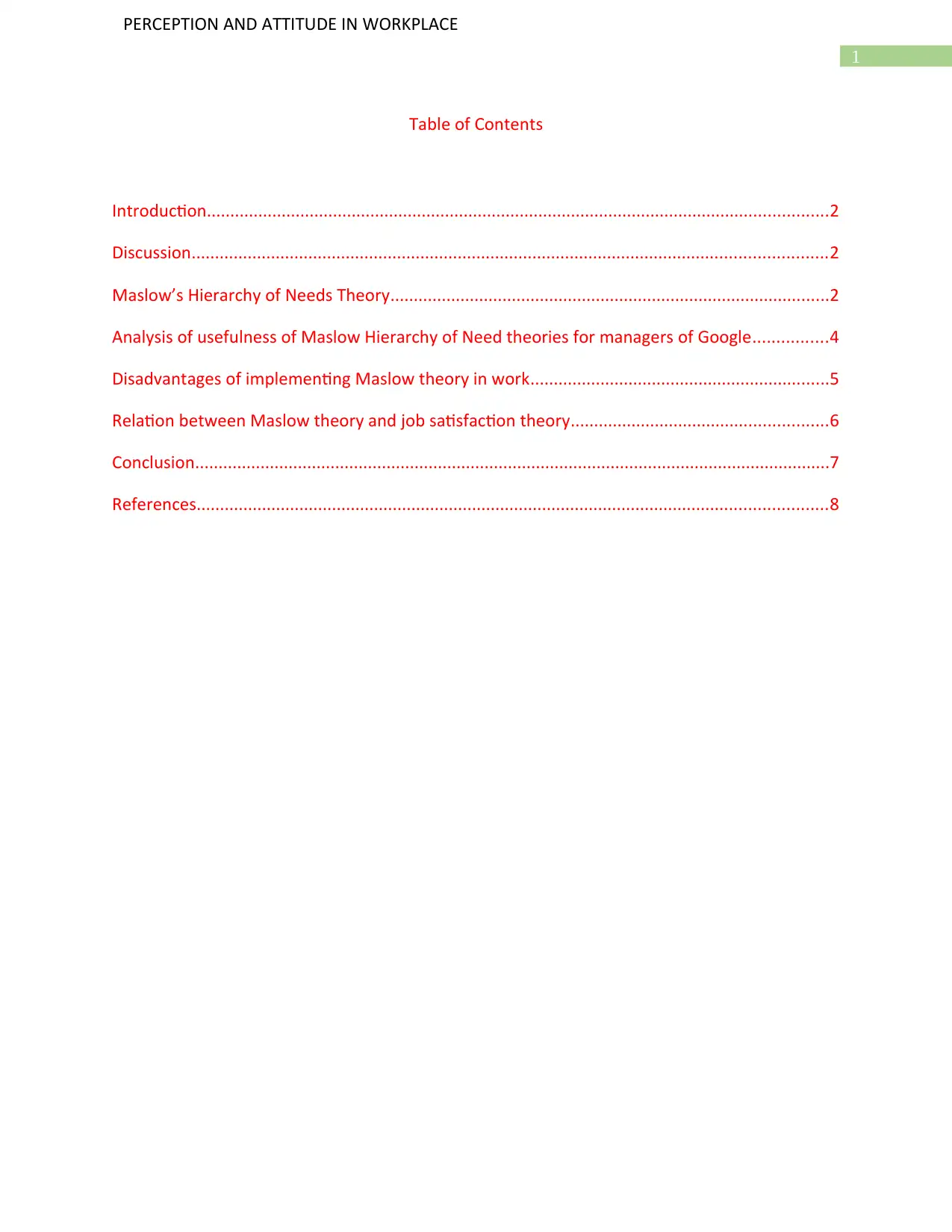
1
PERCEPTION AND ATTITUDE IN WORKPLACE
Table of Contents
Introduction.....................................................................................................................................2
Discussion........................................................................................................................................2
Maslow’s Hierarchy of Needs Theory..............................................................................................2
Analysis of usefulness of Maslow Hierarchy of Need theories for managers of Google................4
Disadvantages of implementing Maslow theory in work................................................................5
Relation between Maslow theory and job satisfaction theory.......................................................6
Conclusion........................................................................................................................................7
References.......................................................................................................................................8
PERCEPTION AND ATTITUDE IN WORKPLACE
Table of Contents
Introduction.....................................................................................................................................2
Discussion........................................................................................................................................2
Maslow’s Hierarchy of Needs Theory..............................................................................................2
Analysis of usefulness of Maslow Hierarchy of Need theories for managers of Google................4
Disadvantages of implementing Maslow theory in work................................................................5
Relation between Maslow theory and job satisfaction theory.......................................................6
Conclusion........................................................................................................................................7
References.......................................................................................................................................8
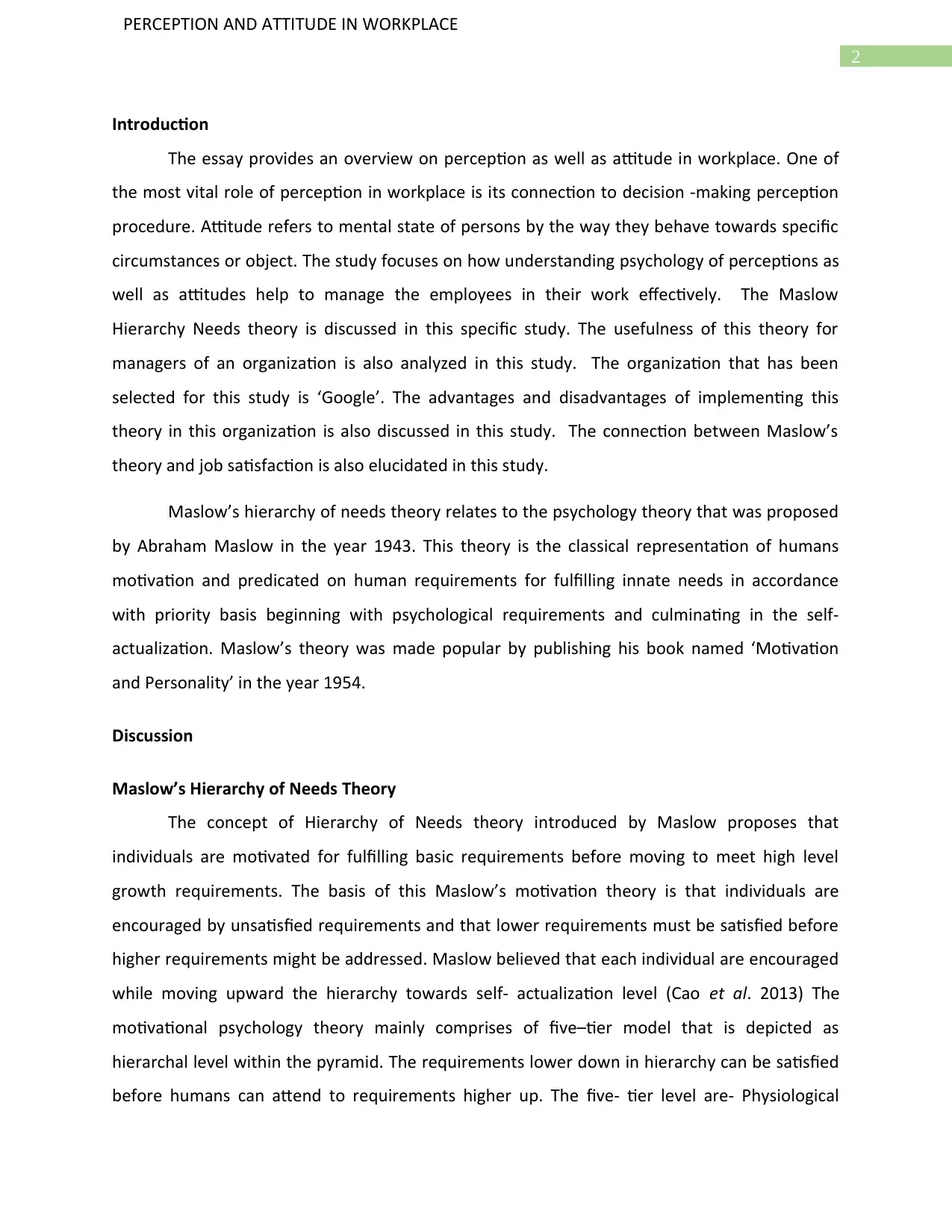
2
PERCEPTION AND ATTITUDE IN WORKPLACE
Introduction
The essay provides an overview on perception as well as attitude in workplace. One of
the most vital role of perception in workplace is its connection to decision -making perception
procedure. Attitude refers to mental state of persons by the way they behave towards specific
circumstances or object. The study focuses on how understanding psychology of perceptions as
well as attitudes help to manage the employees in their work effectively. The Maslow
Hierarchy Needs theory is discussed in this specific study. The usefulness of this theory for
managers of an organization is also analyzed in this study. The organization that has been
selected for this study is ‘Google’. The advantages and disadvantages of implementing this
theory in this organization is also discussed in this study. The connection between Maslow’s
theory and job satisfaction is also elucidated in this study.
Maslow’s hierarchy of needs theory relates to the psychology theory that was proposed
by Abraham Maslow in the year 1943. This theory is the classical representation of humans
motivation and predicated on human requirements for fulfilling innate needs in accordance
with priority basis beginning with psychological requirements and culminating in the self-
actualization. Maslow’s theory was made popular by publishing his book named ‘Motivation
and Personality’ in the year 1954.
Discussion
Maslow’s Hierarchy of Needs Theory
The concept of Hierarchy of Needs theory introduced by Maslow proposes that
individuals are motivated for fulfilling basic requirements before moving to meet high level
growth requirements. The basis of this Maslow’s motivation theory is that individuals are
encouraged by unsatisfied requirements and that lower requirements must be satisfied before
higher requirements might be addressed. Maslow believed that each individual are encouraged
while moving upward the hierarchy towards self- actualization level (Cao et al. 2013) The
motivational psychology theory mainly comprises of five–tier model that is depicted as
hierarchal level within the pyramid. The requirements lower down in hierarchy can be satisfied
before humans can attend to requirements higher up. The five- tier level are- Physiological
PERCEPTION AND ATTITUDE IN WORKPLACE
Introduction
The essay provides an overview on perception as well as attitude in workplace. One of
the most vital role of perception in workplace is its connection to decision -making perception
procedure. Attitude refers to mental state of persons by the way they behave towards specific
circumstances or object. The study focuses on how understanding psychology of perceptions as
well as attitudes help to manage the employees in their work effectively. The Maslow
Hierarchy Needs theory is discussed in this specific study. The usefulness of this theory for
managers of an organization is also analyzed in this study. The organization that has been
selected for this study is ‘Google’. The advantages and disadvantages of implementing this
theory in this organization is also discussed in this study. The connection between Maslow’s
theory and job satisfaction is also elucidated in this study.
Maslow’s hierarchy of needs theory relates to the psychology theory that was proposed
by Abraham Maslow in the year 1943. This theory is the classical representation of humans
motivation and predicated on human requirements for fulfilling innate needs in accordance
with priority basis beginning with psychological requirements and culminating in the self-
actualization. Maslow’s theory was made popular by publishing his book named ‘Motivation
and Personality’ in the year 1954.
Discussion
Maslow’s Hierarchy of Needs Theory
The concept of Hierarchy of Needs theory introduced by Maslow proposes that
individuals are motivated for fulfilling basic requirements before moving to meet high level
growth requirements. The basis of this Maslow’s motivation theory is that individuals are
encouraged by unsatisfied requirements and that lower requirements must be satisfied before
higher requirements might be addressed. Maslow believed that each individual are encouraged
while moving upward the hierarchy towards self- actualization level (Cao et al. 2013) The
motivational psychology theory mainly comprises of five–tier model that is depicted as
hierarchal level within the pyramid. The requirements lower down in hierarchy can be satisfied
before humans can attend to requirements higher up. The five- tier level are- Physiological
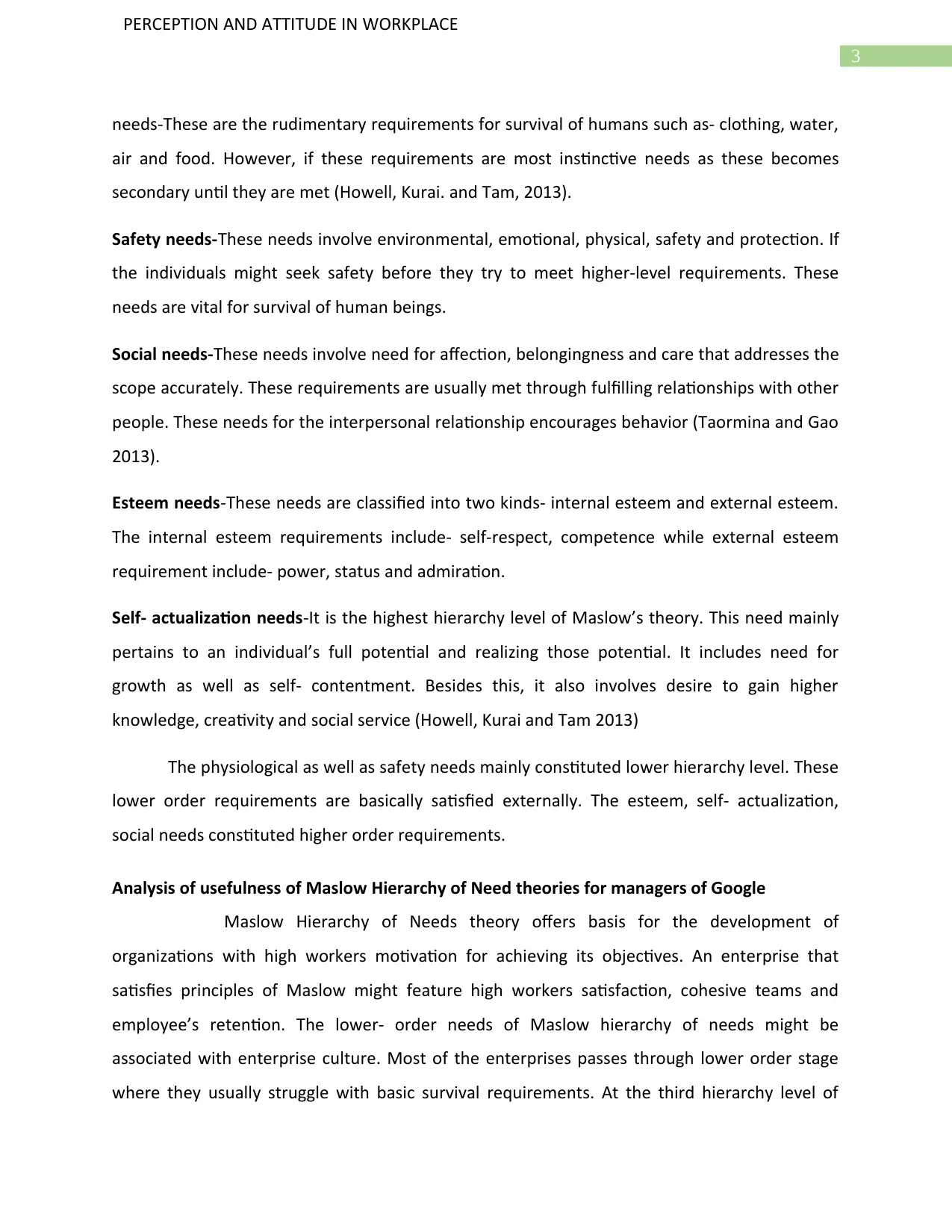
3
PERCEPTION AND ATTITUDE IN WORKPLACE
needs-These are the rudimentary requirements for survival of humans such as- clothing, water,
air and food. However, if these requirements are most instinctive needs as these becomes
secondary until they are met (Howell, Kurai. and Tam, 2013).
Safety needs-These needs involve environmental, emotional, physical, safety and protection. If
the individuals might seek safety before they try to meet higher-level requirements. These
needs are vital for survival of human beings.
Social needs-These needs involve need for affection, belongingness and care that addresses the
scope accurately. These requirements are usually met through fulfilling relationships with other
people. These needs for the interpersonal relationship encourages behavior (Taormina and Gao
2013).
Esteem needs-These needs are classified into two kinds- internal esteem and external esteem.
The internal esteem requirements include- self-respect, competence while external esteem
requirement include- power, status and admiration.
Self- actualization needs-It is the highest hierarchy level of Maslow’s theory. This need mainly
pertains to an individual’s full potential and realizing those potential. It includes need for
growth as well as self- contentment. Besides this, it also involves desire to gain higher
knowledge, creativity and social service (Howell, Kurai and Tam 2013)
The physiological as well as safety needs mainly constituted lower hierarchy level. These
lower order requirements are basically satisfied externally. The esteem, self- actualization,
social needs constituted higher order requirements.
Analysis of usefulness of Maslow Hierarchy of Need theories for managers of Google
Maslow Hierarchy of Needs theory offers basis for the development of
organizations with high workers motivation for achieving its objectives. An enterprise that
satisfies principles of Maslow might feature high workers satisfaction, cohesive teams and
employee’s retention. The lower- order needs of Maslow hierarchy of needs might be
associated with enterprise culture. Most of the enterprises passes through lower order stage
where they usually struggle with basic survival requirements. At the third hierarchy level of
PERCEPTION AND ATTITUDE IN WORKPLACE
needs-These are the rudimentary requirements for survival of humans such as- clothing, water,
air and food. However, if these requirements are most instinctive needs as these becomes
secondary until they are met (Howell, Kurai. and Tam, 2013).
Safety needs-These needs involve environmental, emotional, physical, safety and protection. If
the individuals might seek safety before they try to meet higher-level requirements. These
needs are vital for survival of human beings.
Social needs-These needs involve need for affection, belongingness and care that addresses the
scope accurately. These requirements are usually met through fulfilling relationships with other
people. These needs for the interpersonal relationship encourages behavior (Taormina and Gao
2013).
Esteem needs-These needs are classified into two kinds- internal esteem and external esteem.
The internal esteem requirements include- self-respect, competence while external esteem
requirement include- power, status and admiration.
Self- actualization needs-It is the highest hierarchy level of Maslow’s theory. This need mainly
pertains to an individual’s full potential and realizing those potential. It includes need for
growth as well as self- contentment. Besides this, it also involves desire to gain higher
knowledge, creativity and social service (Howell, Kurai and Tam 2013)
The physiological as well as safety needs mainly constituted lower hierarchy level. These
lower order requirements are basically satisfied externally. The esteem, self- actualization,
social needs constituted higher order requirements.
Analysis of usefulness of Maslow Hierarchy of Need theories for managers of Google
Maslow Hierarchy of Needs theory offers basis for the development of
organizations with high workers motivation for achieving its objectives. An enterprise that
satisfies principles of Maslow might feature high workers satisfaction, cohesive teams and
employee’s retention. The lower- order needs of Maslow hierarchy of needs might be
associated with enterprise culture. Most of the enterprises passes through lower order stage
where they usually struggle with basic survival requirements. At the third hierarchy level of
Secure Best Marks with AI Grader
Need help grading? Try our AI Grader for instant feedback on your assignments.
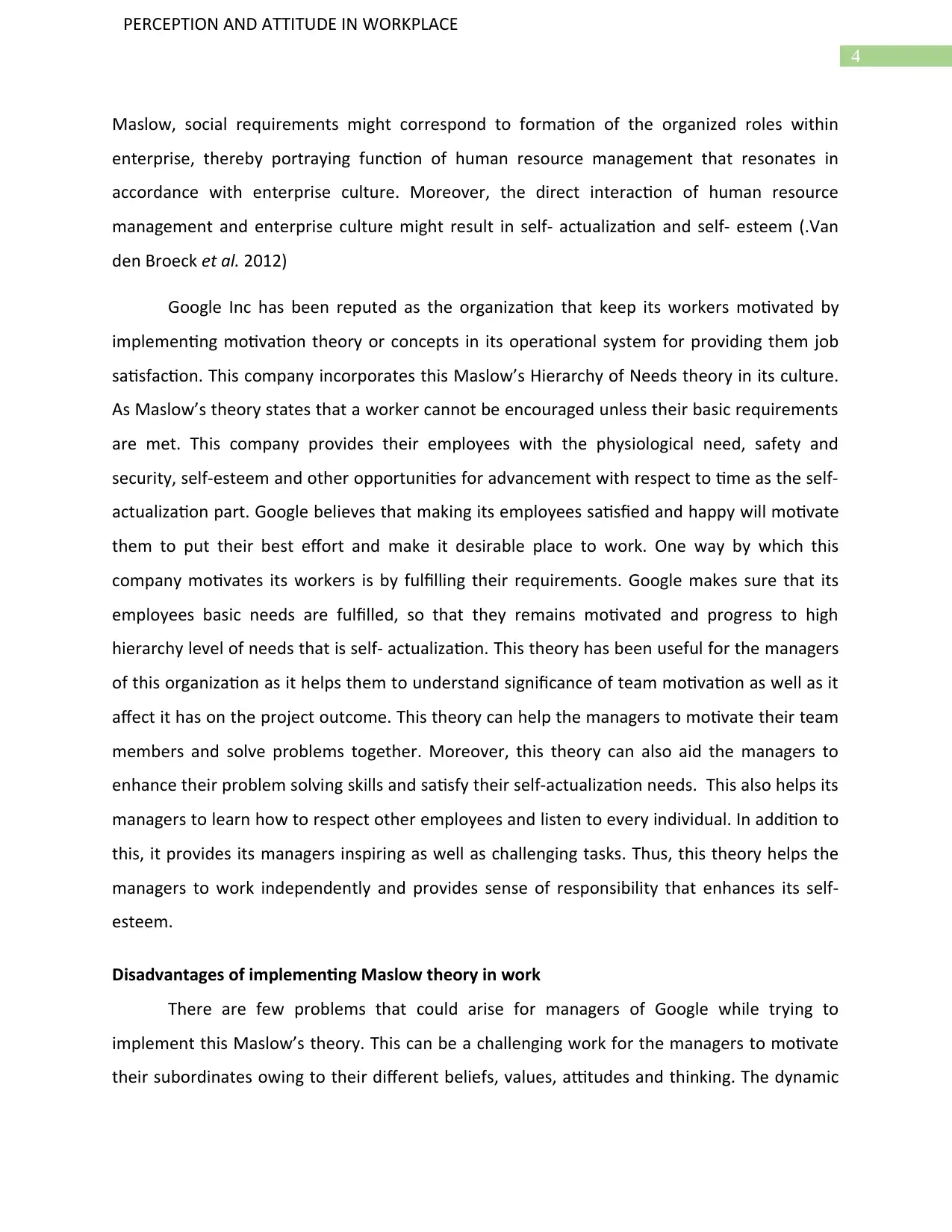
4
PERCEPTION AND ATTITUDE IN WORKPLACE
Maslow, social requirements might correspond to formation of the organized roles within
enterprise, thereby portraying function of human resource management that resonates in
accordance with enterprise culture. Moreover, the direct interaction of human resource
management and enterprise culture might result in self- actualization and self- esteem (.Van
den Broeck et al. 2012)
Google Inc has been reputed as the organization that keep its workers motivated by
implementing motivation theory or concepts in its operational system for providing them job
satisfaction. This company incorporates this Maslow’s Hierarchy of Needs theory in its culture.
As Maslow’s theory states that a worker cannot be encouraged unless their basic requirements
are met. This company provides their employees with the physiological need, safety and
security, self-esteem and other opportunities for advancement with respect to time as the self-
actualization part. Google believes that making its employees satisfied and happy will motivate
them to put their best effort and make it desirable place to work. One way by which this
company motivates its workers is by fulfilling their requirements. Google makes sure that its
employees basic needs are fulfilled, so that they remains motivated and progress to high
hierarchy level of needs that is self- actualization. This theory has been useful for the managers
of this organization as it helps them to understand significance of team motivation as well as it
affect it has on the project outcome. This theory can help the managers to motivate their team
members and solve problems together. Moreover, this theory can also aid the managers to
enhance their problem solving skills and satisfy their self-actualization needs. This also helps its
managers to learn how to respect other employees and listen to every individual. In addition to
this, it provides its managers inspiring as well as challenging tasks. Thus, this theory helps the
managers to work independently and provides sense of responsibility that enhances its self-
esteem.
Disadvantages of implementing Maslow theory in work
There are few problems that could arise for managers of Google while trying to
implement this Maslow’s theory. This can be a challenging work for the managers to motivate
their subordinates owing to their different beliefs, values, attitudes and thinking. The dynamic
PERCEPTION AND ATTITUDE IN WORKPLACE
Maslow, social requirements might correspond to formation of the organized roles within
enterprise, thereby portraying function of human resource management that resonates in
accordance with enterprise culture. Moreover, the direct interaction of human resource
management and enterprise culture might result in self- actualization and self- esteem (.Van
den Broeck et al. 2012)
Google Inc has been reputed as the organization that keep its workers motivated by
implementing motivation theory or concepts in its operational system for providing them job
satisfaction. This company incorporates this Maslow’s Hierarchy of Needs theory in its culture.
As Maslow’s theory states that a worker cannot be encouraged unless their basic requirements
are met. This company provides their employees with the physiological need, safety and
security, self-esteem and other opportunities for advancement with respect to time as the self-
actualization part. Google believes that making its employees satisfied and happy will motivate
them to put their best effort and make it desirable place to work. One way by which this
company motivates its workers is by fulfilling their requirements. Google makes sure that its
employees basic needs are fulfilled, so that they remains motivated and progress to high
hierarchy level of needs that is self- actualization. This theory has been useful for the managers
of this organization as it helps them to understand significance of team motivation as well as it
affect it has on the project outcome. This theory can help the managers to motivate their team
members and solve problems together. Moreover, this theory can also aid the managers to
enhance their problem solving skills and satisfy their self-actualization needs. This also helps its
managers to learn how to respect other employees and listen to every individual. In addition to
this, it provides its managers inspiring as well as challenging tasks. Thus, this theory helps the
managers to work independently and provides sense of responsibility that enhances its self-
esteem.
Disadvantages of implementing Maslow theory in work
There are few problems that could arise for managers of Google while trying to
implement this Maslow’s theory. This can be a challenging work for the managers to motivate
their subordinates owing to their different beliefs, values, attitudes and thinking. The dynamic
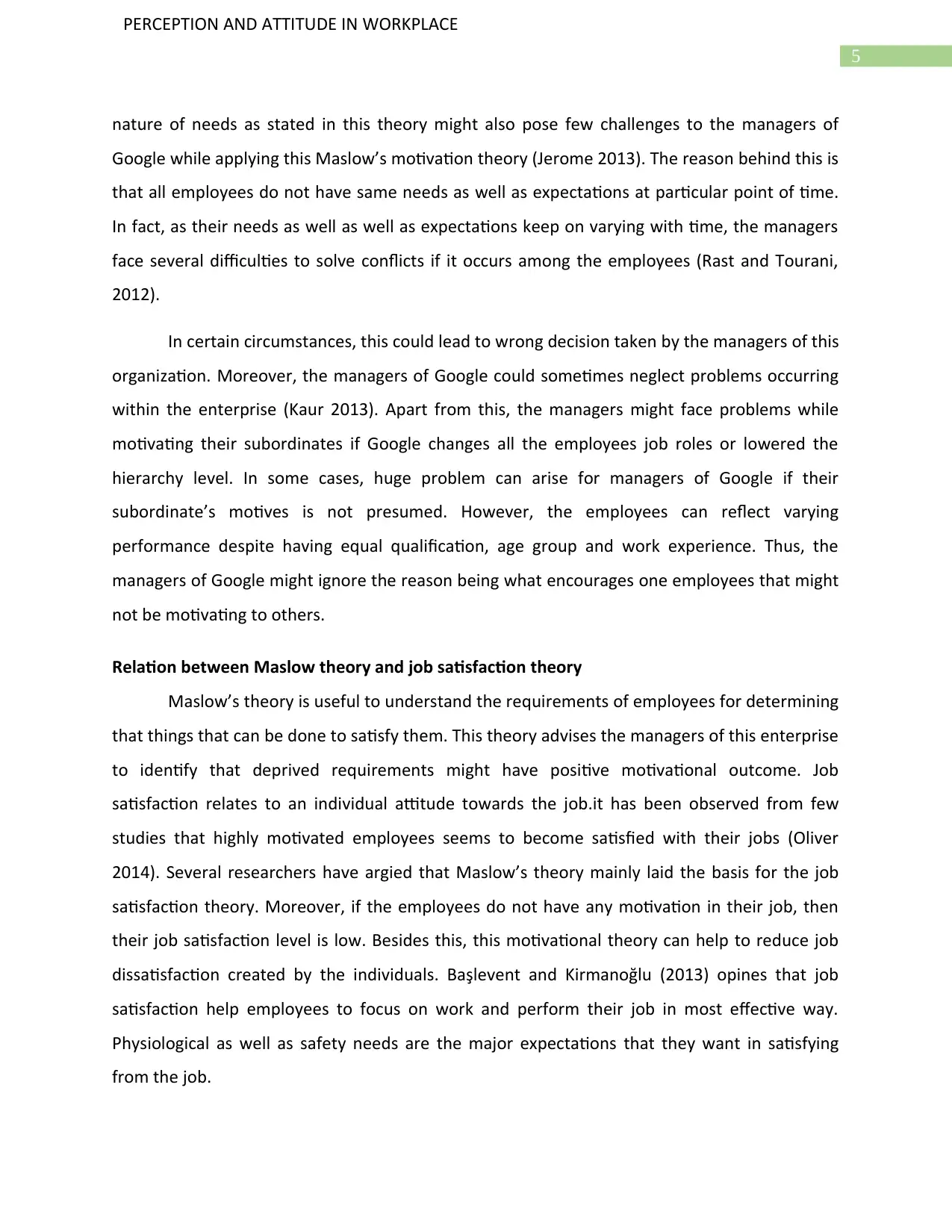
5
PERCEPTION AND ATTITUDE IN WORKPLACE
nature of needs as stated in this theory might also pose few challenges to the managers of
Google while applying this Maslow’s motivation theory (Jerome 2013). The reason behind this is
that all employees do not have same needs as well as expectations at particular point of time.
In fact, as their needs as well as well as expectations keep on varying with time, the managers
face several difficulties to solve conflicts if it occurs among the employees (Rast and Tourani,
2012).
In certain circumstances, this could lead to wrong decision taken by the managers of this
organization. Moreover, the managers of Google could sometimes neglect problems occurring
within the enterprise (Kaur 2013). Apart from this, the managers might face problems while
motivating their subordinates if Google changes all the employees job roles or lowered the
hierarchy level. In some cases, huge problem can arise for managers of Google if their
subordinate’s motives is not presumed. However, the employees can reflect varying
performance despite having equal qualification, age group and work experience. Thus, the
managers of Google might ignore the reason being what encourages one employees that might
not be motivating to others.
Relation between Maslow theory and job satisfaction theory
Maslow’s theory is useful to understand the requirements of employees for determining
that things that can be done to satisfy them. This theory advises the managers of this enterprise
to identify that deprived requirements might have positive motivational outcome. Job
satisfaction relates to an individual attitude towards the job.it has been observed from few
studies that highly motivated employees seems to become satisfied with their jobs (Oliver
2014). Several researchers have argied that Maslow’s theory mainly laid the basis for the job
satisfaction theory. Moreover, if the employees do not have any motivation in their job, then
their job satisfaction level is low. Besides this, this motivational theory can help to reduce job
dissatisfaction created by the individuals. Başlevent and Kirmanoğlu (2013) opines that job
satisfaction help employees to focus on work and perform their job in most effective way.
Physiological as well as safety needs are the major expectations that they want in satisfying
from the job.
PERCEPTION AND ATTITUDE IN WORKPLACE
nature of needs as stated in this theory might also pose few challenges to the managers of
Google while applying this Maslow’s motivation theory (Jerome 2013). The reason behind this is
that all employees do not have same needs as well as expectations at particular point of time.
In fact, as their needs as well as well as expectations keep on varying with time, the managers
face several difficulties to solve conflicts if it occurs among the employees (Rast and Tourani,
2012).
In certain circumstances, this could lead to wrong decision taken by the managers of this
organization. Moreover, the managers of Google could sometimes neglect problems occurring
within the enterprise (Kaur 2013). Apart from this, the managers might face problems while
motivating their subordinates if Google changes all the employees job roles or lowered the
hierarchy level. In some cases, huge problem can arise for managers of Google if their
subordinate’s motives is not presumed. However, the employees can reflect varying
performance despite having equal qualification, age group and work experience. Thus, the
managers of Google might ignore the reason being what encourages one employees that might
not be motivating to others.
Relation between Maslow theory and job satisfaction theory
Maslow’s theory is useful to understand the requirements of employees for determining
that things that can be done to satisfy them. This theory advises the managers of this enterprise
to identify that deprived requirements might have positive motivational outcome. Job
satisfaction relates to an individual attitude towards the job.it has been observed from few
studies that highly motivated employees seems to become satisfied with their jobs (Oliver
2014). Several researchers have argied that Maslow’s theory mainly laid the basis for the job
satisfaction theory. Moreover, if the employees do not have any motivation in their job, then
their job satisfaction level is low. Besides this, this motivational theory can help to reduce job
dissatisfaction created by the individuals. Başlevent and Kirmanoğlu (2013) opines that job
satisfaction help employees to focus on work and perform their job in most effective way.
Physiological as well as safety needs are the major expectations that they want in satisfying
from the job.
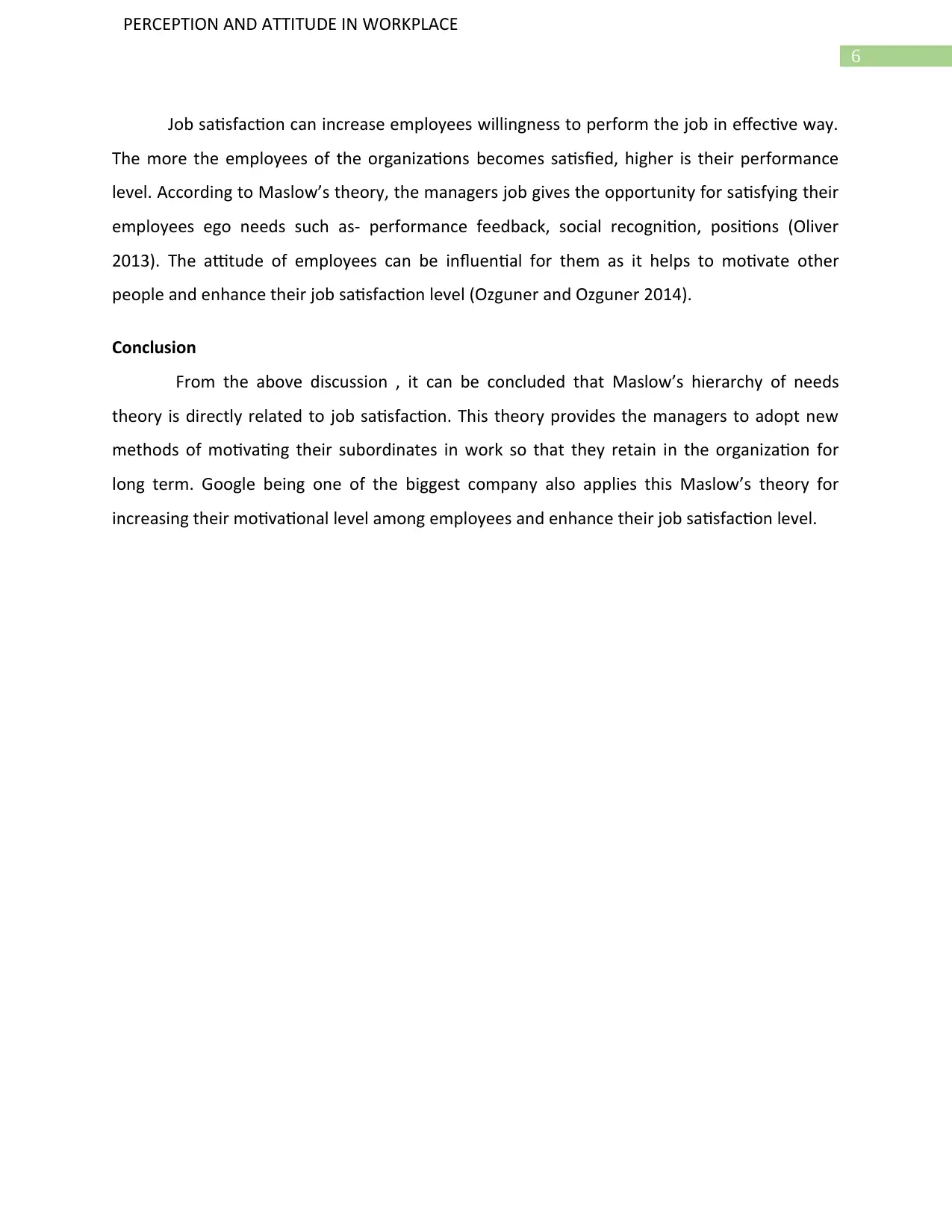
6
PERCEPTION AND ATTITUDE IN WORKPLACE
Job satisfaction can increase employees willingness to perform the job in effective way.
The more the employees of the organizations becomes satisfied, higher is their performance
level. According to Maslow’s theory, the managers job gives the opportunity for satisfying their
employees ego needs such as- performance feedback, social recognition, positions (Oliver
2013). The attitude of employees can be influential for them as it helps to motivate other
people and enhance their job satisfaction level (Ozguner and Ozguner 2014).
Conclusion
From the above discussion , it can be concluded that Maslow’s hierarchy of needs
theory is directly related to job satisfaction. This theory provides the managers to adopt new
methods of motivating their subordinates in work so that they retain in the organization for
long term. Google being one of the biggest company also applies this Maslow’s theory for
increasing their motivational level among employees and enhance their job satisfaction level.
PERCEPTION AND ATTITUDE IN WORKPLACE
Job satisfaction can increase employees willingness to perform the job in effective way.
The more the employees of the organizations becomes satisfied, higher is their performance
level. According to Maslow’s theory, the managers job gives the opportunity for satisfying their
employees ego needs such as- performance feedback, social recognition, positions (Oliver
2013). The attitude of employees can be influential for them as it helps to motivate other
people and enhance their job satisfaction level (Ozguner and Ozguner 2014).
Conclusion
From the above discussion , it can be concluded that Maslow’s hierarchy of needs
theory is directly related to job satisfaction. This theory provides the managers to adopt new
methods of motivating their subordinates in work so that they retain in the organization for
long term. Google being one of the biggest company also applies this Maslow’s theory for
increasing their motivational level among employees and enhance their job satisfaction level.
Paraphrase This Document
Need a fresh take? Get an instant paraphrase of this document with our AI Paraphraser

7
PERCEPTION AND ATTITUDE IN WORKPLACE
References
Başlevent, C. and Kirmanoğlu, H., 2013. Do preferences for job attributes provide evidence of
‘Hierarchy of Needs’?. Social indicators research, 111(2), pp.549-560.
Cao, H., Jiang, J., Oh, L.B., Li, H., Liao, X. and Chen, Z., 2013. A Maslow's hierarchy of needs
analysis of social networking services continuance. Journal of Service Management, 24(2),
pp.170-190.
Howell, R.T., Kurai, M. and Tam, L., 2013. Money buys financial security and psychological need
satisfaction: Testing need theory in affluence. Social Indicators Research, 110(1), pp.17-29.
Jerome, N., 2013. Application of the Maslow’s of need theory; impacts and implications on
organizational culture, human resource and hierarchy employee’s performance. International
Journal of Business and Management Invention, 2(3), pp.39-45.
Kaur, A., 2013. Maslow’s need hierarchy theory: Applications and criticisms. Global Journal of
Management and Business Studies, 3(10), pp.1061-1064.
Oliver, R.L., 2014. Satisfaction: A Behavioral Perspective on the Consumer: A Behavioral
Perspective on the Consumer. Routledge.
Ozguner, Z. and Ozguner, M., 2014. A managerial point of view on the relationship between of
Maslow's hierarchy of needs and Herzberg's dual factor theory. International Journal of
Business and Social Science, 5(7).
Rast, S. and Tourani, A., 2012. Evaluation of employees' job satisfaction and role of gender
difference: An empirical study at airline industry in Iran. International Journal of Business and
Social Science, 3(7).
Taormina, R.J. and Gao, J.H., 2013. Maslow and the motivation hierarchy: Measuring
satisfaction of the needs. The American journal of psychology, 126(2), pp.155-177.
PERCEPTION AND ATTITUDE IN WORKPLACE
References
Başlevent, C. and Kirmanoğlu, H., 2013. Do preferences for job attributes provide evidence of
‘Hierarchy of Needs’?. Social indicators research, 111(2), pp.549-560.
Cao, H., Jiang, J., Oh, L.B., Li, H., Liao, X. and Chen, Z., 2013. A Maslow's hierarchy of needs
analysis of social networking services continuance. Journal of Service Management, 24(2),
pp.170-190.
Howell, R.T., Kurai, M. and Tam, L., 2013. Money buys financial security and psychological need
satisfaction: Testing need theory in affluence. Social Indicators Research, 110(1), pp.17-29.
Jerome, N., 2013. Application of the Maslow’s of need theory; impacts and implications on
organizational culture, human resource and hierarchy employee’s performance. International
Journal of Business and Management Invention, 2(3), pp.39-45.
Kaur, A., 2013. Maslow’s need hierarchy theory: Applications and criticisms. Global Journal of
Management and Business Studies, 3(10), pp.1061-1064.
Oliver, R.L., 2014. Satisfaction: A Behavioral Perspective on the Consumer: A Behavioral
Perspective on the Consumer. Routledge.
Ozguner, Z. and Ozguner, M., 2014. A managerial point of view on the relationship between of
Maslow's hierarchy of needs and Herzberg's dual factor theory. International Journal of
Business and Social Science, 5(7).
Rast, S. and Tourani, A., 2012. Evaluation of employees' job satisfaction and role of gender
difference: An empirical study at airline industry in Iran. International Journal of Business and
Social Science, 3(7).
Taormina, R.J. and Gao, J.H., 2013. Maslow and the motivation hierarchy: Measuring
satisfaction of the needs. The American journal of psychology, 126(2), pp.155-177.

8
PERCEPTION AND ATTITUDE IN WORKPLACE
Van den Broeck, A., Ferris, D.L., Chang, C.H. and Rosen, C.C., 2016. A review of self-
determination theory’s basic psychological needs at work. Journal of Management, 42(5),
pp.1195-1229.
PERCEPTION AND ATTITUDE IN WORKPLACE
Van den Broeck, A., Ferris, D.L., Chang, C.H. and Rosen, C.C., 2016. A review of self-
determination theory’s basic psychological needs at work. Journal of Management, 42(5),
pp.1195-1229.
1 out of 9
Related Documents
Your All-in-One AI-Powered Toolkit for Academic Success.
+13062052269
info@desklib.com
Available 24*7 on WhatsApp / Email
![[object Object]](/_next/static/media/star-bottom.7253800d.svg)
Unlock your academic potential
© 2024 | Zucol Services PVT LTD | All rights reserved.




